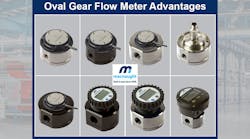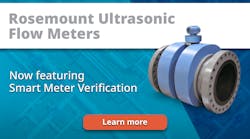Ask the Expert: Increasing Need for Safe Hydrogen Loading and Unloading Requires Cutting-Edge Technology
Emerson’s Micro Motion HPC020 High-Pressure Coriolis Flow Meter has a larger nominal flow rate than previous products, expanding the ability to safely dispense hydrogen fuel at the efficiency required for heavy duty vehicles, all while meeting or exceeding government flow specifications.
With environmental concerns moving to the forefront of daily life, more vehicle manufacturers are introducing hydrogen-powered vehicles into service. Producers of everything from large semi-trailer trucks to buses and passenger cars are jumping on the technology that provides extended driving range with zero greenhouse gas emissions—water being the only by-product. One major concern, however, is the safety and reliability of dispensing hydrogen into those vehicles, while adhering to both governmental regulations and industry safety standards. Emerson has developed a solution for both of those issues:
The Micro Motion HPC020 High-Pressure Coriolis Flow Meter. Genny Fultz, product manager and market expansion researcher for Emerson, answers some frequently asked questions about the HPC020.
How does the HPC020 differ from previous products such as the HPC015?
A: When hydrogen was first developed as a fuel, there were no regulations for it. Pretty quickly, SAE International came up with a standard called SAE J2601-1, which is a recommendation for hydrogen dispensing for trucks and passenger cars. Our HPC platform has been designed to meet the flow requirements of International standards of Hydrogen refueling, mostly the SAE J2601-1. It corresponds to 3,6kg/mn for the HPC015 and 7,2kg/mn for the HPC020. It means the HPC015 is specifically suitable for refueling Light & Medium duty vehicles such as cars and industrial vehicles while the HPC020 offers flexibility for all types of vehicles, including heavy duty and bus. The dimensions for the HPC020 are the same compact ones as the HPC015, and it offers the same electronic configurations, process connections, and Smart Meter Verification software. The main difference is flow rate, which is a real time and money saver.
With the increasing demand for loading and unloading high-pressure hydrogen into vehicles, how does the HPC020 perform better than previous models in those applications?
A: We found there is a market for filling larger commercial and passenger vehicles at a faster rate to keep the time of the fill similar to what it would take to fill a diesel truck. For truck drivers, time is money, and a faster fill means they can get back on the road more quickly. In addition to dispensing applications, we’ve also found a need for measurement at the tube trailer loading and offloading point within the hydrogen fuel transportation value chain. Between the production and the consumption for example, the design of the HPC020 reflects those changes in the market by utilizing sensor components that are slightly different than the HPC015 to allow for a higher flow rate while still keeping the 0.5% batch accuracy.
What are some of the challenges facing users in metering hydrogen with regards to temperature, pressure, and accuracy?
A: Hydrogen offers a great opportunity to use sustainable energy sources to fuel vehicles of all different types and sizes. Like other gaseous fuels, it can be compressed and kept at high pressures to pack the most miles possible into a single fueling. A flow meter used in the batch fueling process needs to remain accurate over a very wide and dynamic range of conditions, including pressures in excess of 10,000 psi from –40° C to 60° C ambient. One of the biggest challenges is temperature, due to the nature of the gas. Coriolis technology simply offers the best solution for meeting these demands. The performance of our HPC platform has been fully tested and witnessed by Notified Bodies during the metrological certification process including evaluation of the pressure and temperature effects on the measurement. As a result, we have obtained the metrology OIML R139 certificate covering the largest flow rate on the market for these H2 dispensing applications, proving the highest performance of our HPCs.
From a safety standpoint, what makes the HPC020 a leader in the field?
A: The HPC020, along with all our high-pressure application sensors, has an austenitic stainless-steel material called XM-19. It has excellent corrosion resistance and produces excellent performance at both high and low temperatures. XM-19 is commonly used in the aviation and nuclear industries when working with hydrogen fuels. It’s also resistant to hydrogen permeation so that prevents a lot of things that would normally break down at the weld point or within the tubes. Stress and cracking can be a problem with other types of metal. Both the HPC015 and the HPC020 use the XM-19 stainless steel to help mitigate that. It’s a good choice because it’s quite strong — it’s twice the strength of 316L. Also, once a sensor has been installed in the field, the likelihood of that meter ever needing any kind of maintenance is very low. That eliminates the need for anybody to open the dispenser because of the flow meter, which is another way of improving safety by reducing the need for any human interaction. Another aspect related to safety is functional safety. Many users and dispenser manufacturers use the flow meters as a safety barrier in their installation and require SIL approval for the device they use. Our HPC platform along with our 5700 transmitters offer the possibility to integrate the Coriolis Mass flow measurement in the safety loop, either for SIL2 or SIL3 level.
How does the HPC020 help a company manage costs?
A: Regular maintenance and yearly replacement of components, which many measurement technologies require, can be costly. Coriolis sensors don’t require any of that and are designed to be installed and left alone to work. This saves companies a lot of money. We also offer our proprietary Smart Meter Verification diagnostic software that uses onboard diagnostics with the flow transmitter to continuously monitor KPIs that maintain measurement accuracy and meter integrity. This reduces costs through early detection of any issues in the process.
Is any training required to use the HPC020?
A: We’re approaching the guidance for the HPC020 by using all of the relevant knowledge of the HPC015 because it’s the exact same case, size, and tube size. It doesn’t require any additional extra training. All of our meters feature a tag that provides access to how-to videos, data sheets, brochures, and everything else to make installation, reordering, and managing of the meter as seamless as possible. And, of course, our salespeople always help with any questions. They go through rigorous training on how to install and handle our products, troubleshooting, etc. Since every Emerson product is built with extreme integrity and unparalleled quality control, they are built to last. Some of our meters are out there performing since we started in the 1970s when Micro Motion was founded. It’s a real testament to their quality and durability.
To learn more about Emerson Micro Motion HPC020 High-Pressure Coriolis Flow Meters, please visit: https://www.emerson.com/micromotionHPC


